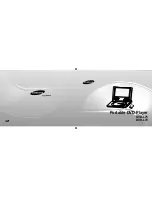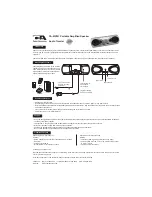
5
Operation
POWER
The ON/OFF switch is on the rear panel of the instrument.
FREQUENCY SELECTION
Frequency range is selected by an eight position multiplier switch with fine adjustment by
calibrated vernier.
SYMMETRY
A slide switch selects the symmetry control which varies the duty cycle 1:6 to 6:1 to produce
sawtooth and variable pulse-width waveforms.
Note: The symmetry of the Aux Output does not vary when Sine or Triangle are selected
because the Aux Output is generated by a zero crossing comparator.
FUNCTION SELECTION
The output waveform shape is selected by a four position switch to give sine, square, triangle
and DC. A DC level only is useful as it permits input threshold testing of a circuit without having
to connect up an external supply.
MAIN OUTPUT
The amplitude of the 50
Ω
MAIN output is controlled by the 3-position ATTENUATOR switches
and AMPLITUDE control. Maximum output is 20 volts peak-to-peak from 50
Ω
and 10 volts peak-
to-peak when terminated with a 50
Ω
load.
The AMPLITUDE control has greater than 26dB range and used in conjunction with the
ATTENTUATORS a range of 0dB to -66dB can be achieved. This provides a range of 20V peak-
to-peak down to 10mV peak-to-peak, or 10V peak-to-peak down to 5mV peak-to-peak into 50
Ω
.
Greater attenuation can be achieved by using standard 50
Ω
BNC attenuators. To maintain
waveform integrity only 50
Ω
cable should be used and the receiving end should be terminated
with a 50
Ω
load. The 50
Ω
MAIN output will withstand a short circuit for a period of 2 minutes at
maximum output and greater periods at lower output levels.
Do not apply external voltages to this output.
DC OFFSET
The DC OFFSET control has a range of ± 10 volts from 50
Ω
in all output modes; the control has
a centre detent for 0 volts. DC offset plus signal peak is limited to ± 10V (± 5V into 50
Ω
). DC
offset plus waveform is attenuated proportionally in the -20dB and -40dB positions.
AUX OUTPUT
The AUX output provides a fixed TTL pulse output at the same frequency and phase as the
50
Ω
MAIN output and is capable of driving 4 standard TTL loads.
SWEEP INPUT
The generator frequency can be swept, DC programmed or modulated by a suitable control
voltage applied to the SWEEP IN socket. The instrument sums the SWEEP IN voltage with the
internal control voltage derived from the FREQUENCY vernier to determine the operating
frequency. A positive voltage increases the frequency; for frequency control with positive-going
DC inputs the vernier should therefore be set to the lower frequency limit of the range to be
swept. For example, a 0V to +2V signal will sweep the generator 1 decade up from range
minimum, set by the vernier, to range maximum.







































